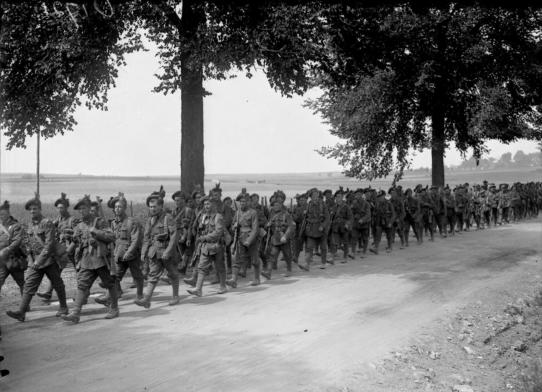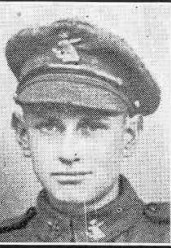In both world wars, there were men killed in action or who died in service who had a connection with Niagara-on-the-Lake but for various reasons were not commemorated on either the memorial clock tower cenotaph in Old Town or the Niagara Township war memorial in Queenston. In some cases, they lived for only a brief time in Niagara and had no family here when the monuments were built. In other instances, they had lived near McNab, not then part of NOTL or Niagara Township. While their names are not read out at the ceremonies at these monuments on Remembrance Day, they too should be remembered.
Edgar George Fisher, known as Ted to his friends, did not choose to be a warrior.
Ted was born in Grimsby on June 22, 1896, the youngest child of Mathias Fisher and Margaret Ferries. Mathias was a farmer in Grimsby.
Before 1911, he moved to Niagara Township with Margaret and young Ted after his other five children left home.
Ted attended the Niagara High School, now part of the Niagara-on-the-Lake Museum, finishing his senior third (grade 11) before leaving school. After the First World War broke out in 1914, Mathias, Margaret and Ted moved back to Grimsby.
While many young Canadian men volunteered for active service during the war, Ted did not enlist.
From 1914 through 1916, voluntary enlistments had been sufficient to maintain a strong Canadian Corps presence in France and Belgium. However, by 1917 enlistments were no longer sufficient to reinforce the army.
The Canadian Corps had suffered heavy losses in battle and through disease. This prompted the government of former prime minister Robert Borden to introduce conscription with the contentious Military Services Act in 1917.
By the end of the war, more than 125,000 Canadian men were conscripted into the army. About 48,000 were sent overseas to England and of these men, 24,000 were sent to France and Belgium to fight. Ted Fisher was among their number.
Ted was drafted into the 2nd Battalion, Central Ontario Regiment, on Feb. 20, 1918. He trained in Canada over the next three months and was shipped to England, arriving in Liverpool on May 27.
Here, he received additional training at Witley Camp. He was considered ready to fight by September.
On Sept. 20, he was temporarily assigned to the 4th Canadian Mounted Rifles and the following day he landed in France. He was again transferred to another regiment, the 85th (Nova Scotia Highlanders) Battalion.
The 85th had suffered very heavy casualties in the Hundred Days campaign, which had begun with the Battle of Amiens on Aug. 5, 1918. Ted joined that unit at the front on Oct. 4.
For the next month, the Canadian Corps was fighting continuously as the German defences of the Hindenburg Line were cracked and the Germans were forced into a fighting withdrawal.
By the time Ted went to war, victory was just around the corner.
From Oct. 28 to Nov. 2, the 85th fought in the Battle of Valenciennes in France, finally capturing that devastated town.
The Germans retreated only to set up a new defensive line, with a heavily defended position established at what was known as Fosse 2 near the town of Quievrechain, close to the Belgian border.
On Nov. 6, the 85th with other battalions was ordered to attack the new heavily defended German position. The battalion set off at 5:30 am.
Canadian artillery set down a heavy rolling barrage, with shells landing just in front of the advancing Canadian troops.
Enemy machine gun fire and mortar bombs swept the field as the Canadians went forward.
The Canadians won the battle, overrunning the German positions at Fosse 2, liberating Quievrechain, crossing the Aunelle River and finally entering Belgium at the Honnelle River.
The 85th suffered 27 men wounded and 15 killed that day. Among them was Private Edgar “Ted” Fisher.
According to the official report, or “Circumstances of Death,” Fisher met his end as such: “Killed in action while taking part with his battalion in the attack on the village of Quievrechain near Valenciennes, he was hit in the head and instantly killed by enemy shrapnel.”
When the smoke cleared, Fisher’s body was recovered and buried in the Valenciennes Communal Cemetery.
This was the last battle for the 85th Battalion in the war that would end only five days after Fisher was killed.
Two years later, his mother received a Silver Cross medal, issued to widows and mothers of the fallen, a memorial scroll and a bronze plaque known as the “dead man’s penny,” honouring his sacrifice.
No doubt the arrival of these memorials caused a new wave of grief over a son who she had described as “a dear boy and a good soldier.”
Fisher was the last man associated with Niagara-on-the-Lake killed in action in the First World War.
On the heels of The Lake Report’s 53-part “Monuments Men” series, which exhaustively documented the story of every soldier commemorated on the town’s two cenotaphs, Ron Dale’s “Missing in Action” stories profile Niagara-on- the-Lake soldiers who died in wartime but are not listed on the town’s monuments.











